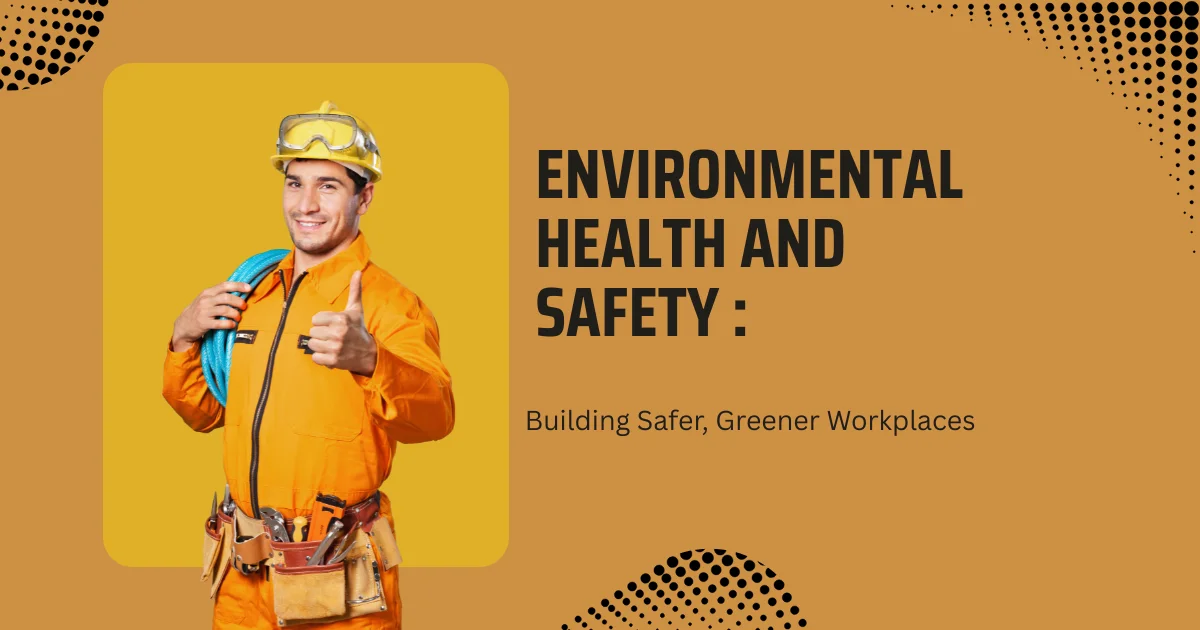In today’s fast-paced world, organizations cannot afford to overlook the importance of Environmental Health and Safety (EHS). From protecting workers against hazards to ensuring that companies meet sustainability goals, EHS has become the backbone of responsible business practices. Whether it’s a construction site, a factory floor, or even a corporate office, maintaining strong health and safety standards is no longer optional—it’s essential for growth, compliance, and reputation.
This blog explores what Environmental Health and Safety really means, why it matters, and how businesses can integrate effective strategies to build a safer and more sustainable workplace culture.
What is Environmental Health and Safety (EHS)?
Environmental Health and Safety (EHS) is a discipline that focuses on creating systems, policies, and practices that protect people and the environment from workplace hazards. It covers everything from preventing accidents to reducing carbon footprints.
In simpler terms, EHS ensures two things:
- Employee Safety: Workers have the right to operate in an environment that prioritizes their physical and mental well-being.
- Environmental Responsibility: Companies must minimize their environmental impact by reducing waste, pollution, and energy consumption.
EHS is not just about regulations—it’s about instilling a culture where safety and sustainability go hand in hand.
Why EHS Matters for Modern Workplaces
- Protects Workers and Saves Lives
Workplace accidents can lead to severe injuries or even fatalities. Strong EHS practices ensure risks are identified, assessed, and minimized before they cause harm.
- Legal and Regulatory Compliance
Governments worldwide impose strict safety and environmental laws. Non-compliance not only attracts penalties but also damages an organization’s reputation. Implementing strong health and safety compliance measures keeps businesses aligned with these legal frameworks.
- Boosts Productivity
Employees are more engaged and productive when they feel safe and valued. An unsafe workplace, on the other hand, increases absenteeism, turnover, and costs.
- Supports Sustainability Goals
EHS encourages businesses to adopt eco-friendly practices, from energy-efficient systems to sustainable waste management. This creates long-term value for both the planet and the business.
Core Components of Environmental Health and Safety
- Hazard Identification and Risk Assessment (HIRA)
Every EHS program begins with identifying potential hazards. Whether it’s chemical exposure, machine-related risks, or ergonomic issues, businesses need to evaluate and control them.
- Training and Education
Knowledge is power. Health & safety training ensures employees understand safety procedures, emergency response, and the importance of following EHS protocols.
- Incident Reporting and Analysis
Accidents should never be swept under the rug. Proper reporting systems help organizations analyze incidents and prevent them from recurring.
- Environmental Management
This involves reducing waste, recycling, conserving energy, and adopting greener technologies to lower the company’s environmental footprint.
- Continuous Monitoring and Improvement
EHS isn’t a one-time activity. Regular audits, reviews, and updates keep programs relevant and effective.
Challenges in Implementing EHS
While the benefits of EHS are undeniable, businesses often struggle with:
- Resistance to Change: Employees and managers may resist new safety measures.
- High Initial Costs: Investing in safety equipment, training, or eco-friendly systems requires upfront resources.
- Keeping Up with Regulations: EHS laws change frequently, making compliance a continuous task.
- Global Workforces: For multinational companies, ensuring consistent EHS standards across different regions can be complex.
Addressing these challenges requires leadership commitment, innovative tools, and a long-term perspective.
The Role of Technology in EHS
Technology has become a game-changer in improving workplace safety and sustainability. For instance:
- Wearable Devices: Track workers’ health in real time.
- EHS Management Software: Helps in reporting, monitoring, and compliance management.
- Simulation Tools: Interactive methods like health and safety animation make training engaging and memorable, helping employees understand risks better than traditional manuals.
Building a Culture of Environmental Health and Safety
Successful EHS programs don’t stop at policies and audits—they focus on culture. Here’s how organizations can foster one:
- Leadership Commitment: Leaders must set the example by actively participating in EHS initiatives.
- Employee Involvement: Encourage workers to report hazards and suggest improvements.
- Open Communication: Transparent communication builds trust and helps identify problems early.
- Recognition Programs: Rewarding safe practices motivates employees to stay committed.
Case Study: The Ripple Effect of Strong EHS Practices
Consider a manufacturing company that invests in proper safety gear, conducts regular training, and implements eco-friendly production methods. Within a year, they not only reduce accidents but also save energy costs and build a strong employer brand. Job applicants prefer companies with a reputation for prioritizing safety and sustainability, while clients are more likely to trust them with long-term contracts.
This ripple effect shows how EHS can transform organizations from the inside out.
Future of EHS – What Lies Ahead?
The future of Environmental Health and Safety is being shaped by global trends like climate change, digital transformation, and employee well-being. Businesses will need to:
- Adopt AI and IoT for predictive safety.
- Embrace sustainability reporting as part of corporate strategy.
- Integrate mental health into safety programs.
- Use immersive training methods like VR and AR to simulate real-life hazards.
Companies that adapt early will not only ensure compliance but also gain a competitive edge.
